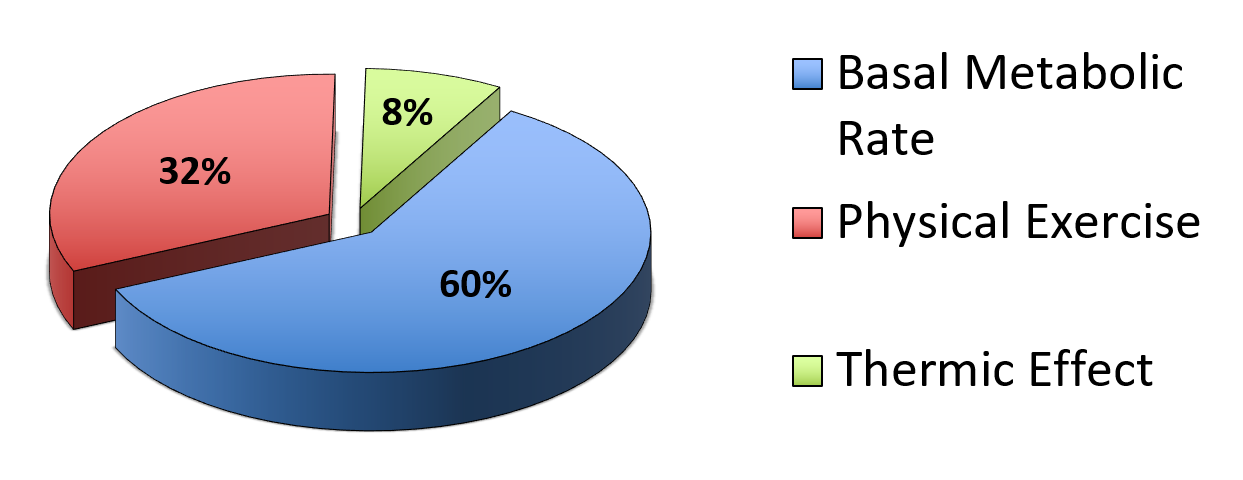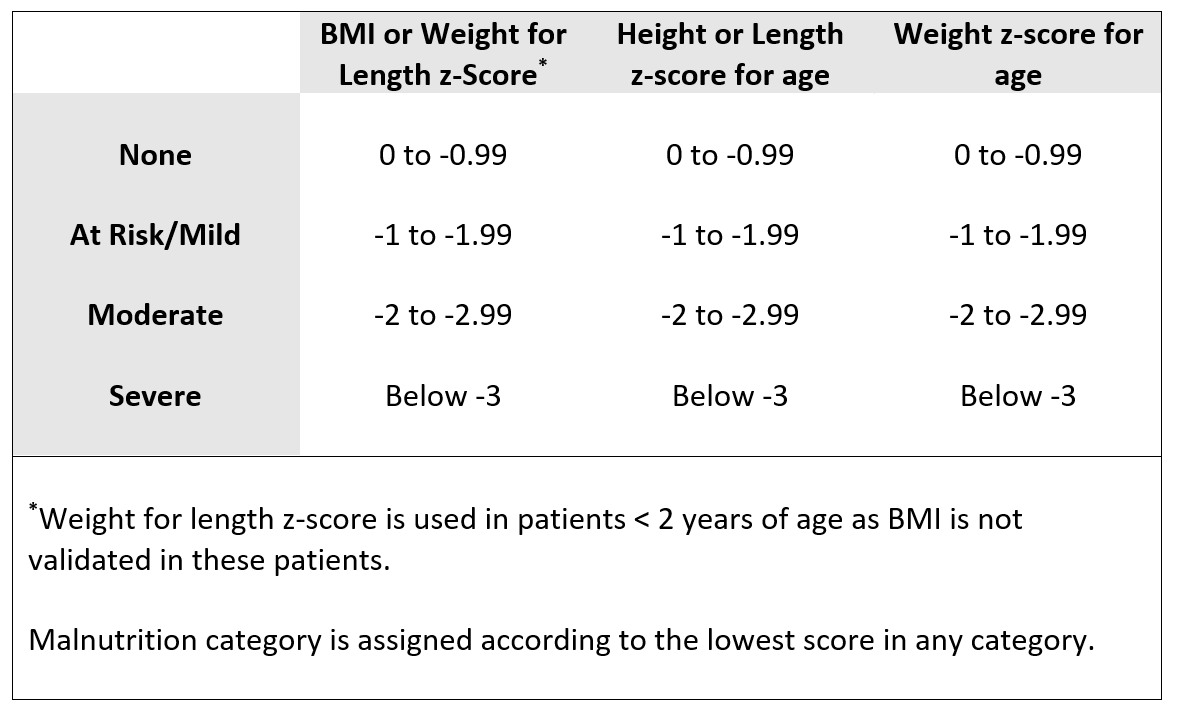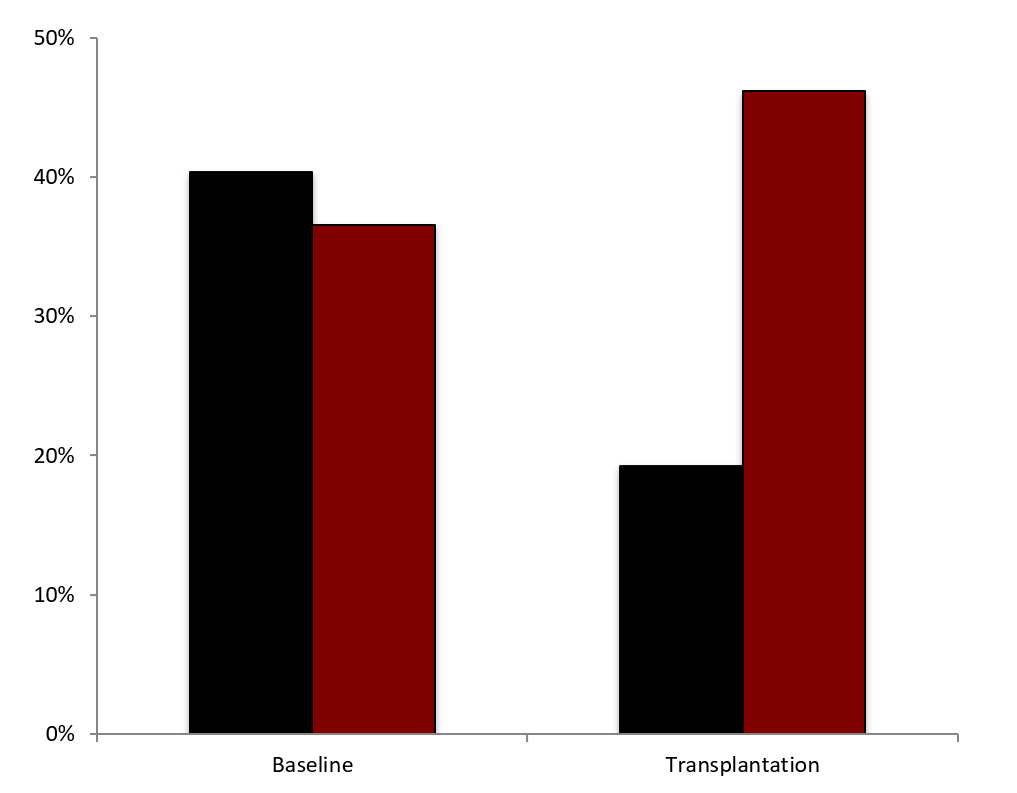Malnutrition in Pediatric Heart Failure
Malnutrition is common in pediatric heart failure due to many factors.1 Decreased intake secondary to fatigue, abdominal pain and anorexia coupled with increased nutrient requirements resulting from gastrointestinal losses, inflammation, hypermetabolism and malabsorption all lead to a deficit of available energy to meet increased metabolic needs.2-6 The importance of nutrition in both pediatric and adult heart failure cannot be overstated, as malnutrition has been associated with both poor wait list outcomes and reduced post-transplant survival.7-11
Defining Malnutrition
Malnutrition is best defined as "an imbalance between nutrient requirement and intake, resulting in cumulative deficits of energy, protein, or micronutrients that may negatively affect growth, development, and other relevant outcomes."4 Malnutrition occurs when energy expenditure exceeds energy intake. One's total energy expenditure (TEE) is comprised of three elements: the basal metabolic rate, which accounts for roughly 60% of energy needs, physical exercise, which accounts for about 32%, and the "thermic effect," defined as the energy required to convert energy from food into a storable form, making up the remaining 8%. (Figure 1)
Figure 1
In disease states, including heart failure, perturbations on both sides of the energy equation occur. Inflammation, increases in metabolic demand and chronic disease all raise the basal metabolic rate while nutritional intake is limited as a result of several factors, including malabsorption, intolerance of eating and interruptions of feedings secondary to clinical instability or the need for medical procedures. When this catabolic state persists, the body is forced to "balance" the energy equation by diverting energy away from other critical functions, like growth and healing.5,12 When this inability to maintain adequate bodily performance processes ensues, one is said to be malnourished.
One historical barrier to the study of malnutrition in children has been a lack of standardized definitions of malnutrition severity, making comparisons between groups and over time in individuals difficult. The recent release of the American Society of Parenteral and Enteral Nutrition (ASPEN) definitions of malnutrition and the Michigan Pediatric Malnutrition Diagnostic Tool (MTool), however, now provide a categorical schema classifying malnutrition severity according to a child's z-score for height/length, weight, and/or body mass index (BMI)/weight for length (Figure 2). Although still relatively new, these definitions, which are derived from expert consensus and conform to World Health Organization (WHO) standard growth curves, have been used for the study of malnutrition in several pediatric patient populations, including critically ill children.13-16 For heart failure patients, because single point-in-time measurements of recorded weight may be influenced by fluctuating fluid status, our practice has been to categorize ASPEN malnutrition severity based on use of the weight at a time when the patient was believed to be euvolemic, which we define as the lowest weight within a 7-day period.
Figure 2
Malnutrition in Children with Heart Failure
Malnutrition is highly prevalent in pediatric heart failure. According to the Pediatric Cardiomyopathy Registry, 23.7% of children with dilated cardiomyopathy are malnourished, and several studies have shown that between 14-18% of children on the heart transplant wait list have a BMI below the 5th percentile.1,9,10 Furthermore, the importance of nutritional status on outcomes is well established. In children, Godown et al. reported that a BMI greater than the 95th or below the 1st percentile was a risk factor for both waitlist and post-transplant mortality in cardiomyopathy patients.10 In a separate analysis, Godown et al. reported that 12% of waitlisted children less than 2 years of age were moderately or severely wasted, and that wasting was a risk factor for wait list mortality.17 After transplant, Rossano et al. reported that 21% of children had a BMI below the 5th percentile at transplant and that being underweight was an independent predictor of reduced graft survival.8
Despite demonstrating both the prevalence and deleterious effects of malnutrition in heart failure patients, supporting literature on the reversibility of malnutrition in these patients is scant. In a forthcoming study to be published in the journal Pediatric Transplantation, we report that nearly half of children awaiting heart transplantation are moderately or severely malnourished, and that intolerance of oral or enteral feeds is common at the time of listing or ventricular assist device (VAD) implantation.18 Although tolerance of enteral feeds improves during the listing period, the need for supplemental enteral and/or parenteral nutrition persists in the majority of patients. We also found that VAD support facilitates nutritional rehabilitation, with VAD patients showing significant improvements in weight-for-age and/or BMI for age z-scores during the listing period, compared to medically managed patients who tend to worsen (Figure 3). VAD support is likely effective because it both reduces heart failure symptoms and improves hemodynamics, allowing for a concomitant increase dietary intake while reducing metabolic demand and nutrient losses. Interestingly, improvements in nutritional status occur primarily due to weight gain, whereas longitudinal growth remains stunted. Although the mechanisms are unclear, similar findings are seen in congenital heart disease patients for whom growth restriction has been demonstrated in both cyanotic and acyanotic lesions, and often persists for several years after surgical palliation or transplantation.19-21 The capacity for nutritional rehabilitation to alter waitlist or post-transplant outcomes remains the subject of ongoing study.
Figure 3
Future Directions
With increasing recognition of both its prevalence and importance on heart failure and transplant outcomes, improving the nutritional status of these children will likely be the focus of further study.
Research on this subject will be aided by the more consistent use of current standardized definitions, which will allow for more appropriate comparisons between groups as well as before and after interventions. With this better understanding, we will be one step closer to a more nuanced approach to modifying the risks associated with malnutrition in pediatric heart failure and improving patient outcomes overall.
Acknowledgements
Dr. Hollander would like to acknowledge Lisa Schultz, RD for her valuable contribution to this review.
References
- Castleberry CD, Jefferie JL, Shi L, et al. No obesity paradox in pediatric patients with dilated cardiomyopathy. JACC Heart Fail 2018;6:222-30.
- Hollander SA, Addonizio LJ, Chin C, et al. Abdominal complaints a a common first presentation of heart failure in adolescents with dilated cardiomyopathy. Am J Emerg Med 2013;31:684-6.
- Medoff-Cooper B, Ravishankar C. Nutrition and growth in congenital heart disease: a challenge in children. Curr Opin Cardiol 2013;28:122-9.
- Mehta NM, Corkins MR, Lyman B, et al. Defining pediatric malnutrition: a paradigm shift toward etiology-related definitions. JPEN J Parenter Enteral Nutr 2013;37:460-81.
- Miller TL, Neri D, Extein J, Somarriba G, Strickman-Stein N. Nutrition in pediatric cardiomyopathy. Prog Pediatr Cardiol 2007;24:59-71.
- Detsky AS, Smalley PS, Chang J. The rational clinical examination. Is this patient malnourished? JAMA 1994;271:54-8.
- Grady KL, White-Williams C, Naftel D, et al. Are preoperative obesity and cachexia risk factors for post heart transplant morbidity and mortality: a multi-institutional study of preoperative weight-height indices. J Heart Lung Transplant 1999;18:750-63.
- Rossano JW, Grenier MA, Dreyer WJ, et al. Effect of body mass index on outcome in pediatric heart transplant patients. J Heart Lung Transplant 2007;26:718-23.
- Davies RR, Haldeman S, McCulloch MA, Gidding SS, Pizarro C. Low body mass index is associated with increased waitlist mortality among children listed for heart transplant. J Heart Lung Transplant 2015;34:1462-70.
- Godown J, Donohue JE, Yu S, Friedland-Little JM, Gajarski RJ, Schumacher KR. Differential effect of body mass index on pediatric heart transplant outcomes based on diagnosis. Pediatr Transplant 2014;18:771-6.
- Aziz EF, Javed F, Pratap B, et al. Malnutrition as assessed by nutritional risk index is associated with worse outcome in patients admitted with acute decompensated heart failure: an ACAP-HF data analysis. Heart Int 2011;6:e2.
- Lewis KD, Conway J, Cunningham C, Larsen BMK. Optimizing nutrition in pediatric heart failure: The crisis Is over and now it's time to feed. Nutr Clin Pract 2017:884533617712502.
- de Souza Menezes F, Leite HP, Koch Nogueira PC. Malnutrition as an independent predictor of clinical outcome in critically ill children. Nutrition 2012;28:267-70.
- Grippa RB, Silva PS, Barbosa E, Bresolin NL, Mehta NM, Moreno YM. Nutritional status as a predictor of duration of mechanical ventilation in critically ill children. Nutrition 2017;33:91-5.
- Bagri NK, Jose B, Shah SK, Bhutia TD, Kabra SK, Lodha R. Impact of malnutrition on the outcome of critically ill children. Indian J Pediatr 2015;82:601-5.
- Corkins MR, Balint J, Corkins KG, Bobo E, Plogsted S and Yaworski JA. The A.S.P.E.N. Pediatric Nutrition Support Handbood, 2nd Edition. 2015.
- Godown J, Friedland-Little JM, Gajarski RJ, Yu S, Donohue JE, Schumacher KR. Abnormal nutrition affects waitlist mortality in infants awaiting heart transplant. J Heart Lung Transplant 2014;33:235-40.
- Hollander SA, Schultz L, Dennis K, Hollander AM, Rizzuto S, Murray JM, Rosenthal DN, Almond CS. Nutritional rehabilitation of pediatric patients on ventricular assist device support. J Heart Lung Transplant 2018;37:S65.
- Burch PT, Gerstenberger E, Ravishankar C, et al. Longitudinal assessment of growth in hypoplastic left heart syndrome: results from the single ventricle reconstruction trial. J Am Heart Assoc. 2014;3(3):e000079.
- Burch PT, Ravishankar C, Newburger JW, et al. Assessment of growth 6 years after the Norwood procedure. J Pediatr. 2017;180:270-274 e276.
- Power A, Schultz L, Dennis K, Rizzuto S, Hollander AM, Rosenthal DN, Almond CS, Hollander SA. Growth stunting persists in single ventricle patients after heart transplantation even when nutritional weight gain is achieved. Circulation. 2018;138(Suppl_1):A12593-A12593.
Keywords: Malnutrition, Pediatrics, Heart Failure, Body Mass Index, Nutritional Status, Child Nutrition Disorders, Weight Gain, Basal Metabolism, Risk Factors, Cardiomyopathy, Dilated, Critical Illness, Heart-Assist Devices, Body Weight, Parenteral Nutrition, Total, Heart Transplantation, Chronic Disease, Registries, Abdominal Pain, Hemodynamics, Inflammation
< Back to Listings



